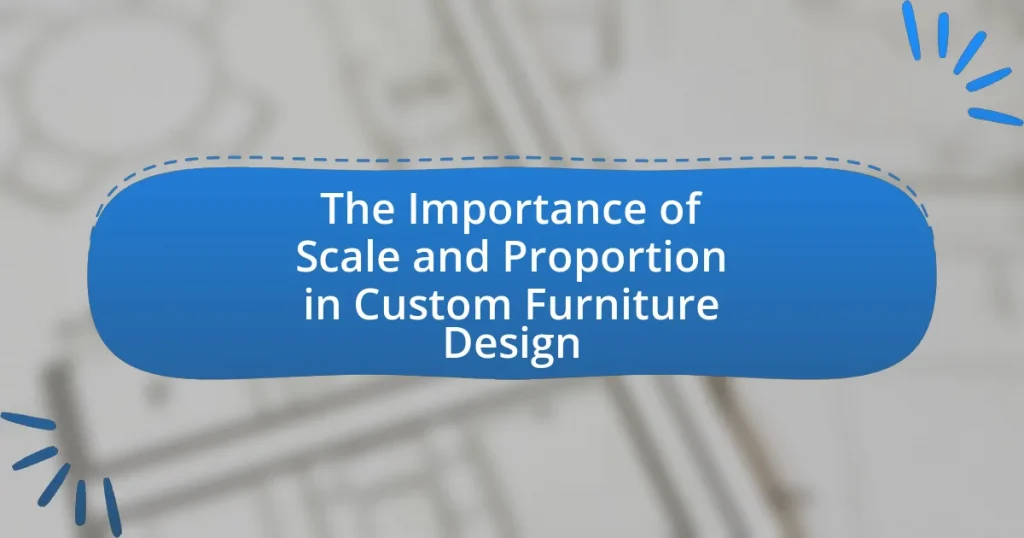The article focuses on the significance of scale and proportion in custom furniture design, emphasizing their role in ensuring that furniture fits harmoniously within a space while meeting functional needs. It explores how proper scale relates to the size of furniture in relation to the environment, and how proportion pertains to the relationship between different dimensions of the furniture itself. Key discussions include the impact of scale and proportion on aesthetics, user comfort, and functionality, as well as common pitfalls designers face. The article also outlines best practices for achieving optimal scale and proportion, techniques for measurement, and the influence of client feedback on design decisions.

What is the significance of scale and proportion in custom furniture design?
Scale and proportion are crucial in custom furniture design as they ensure that pieces fit harmoniously within a space and meet the functional needs of users. Proper scale refers to the size of the furniture in relation to the surrounding environment, while proportion relates to the relationship between different dimensions of the furniture itself. For instance, a sofa that is too large for a small room can overwhelm the space, making it feel cramped, whereas a well-proportioned piece enhances the aesthetic appeal and usability of the area. Studies in design psychology indicate that well-scaled furniture contributes to user comfort and satisfaction, reinforcing the importance of these principles in creating functional and visually pleasing environments.
How do scale and proportion influence the overall aesthetics of furniture?
Scale and proportion significantly influence the overall aesthetics of furniture by determining how well the pieces fit within a given space and relate to each other. When furniture is designed with appropriate scale, it ensures that the size of each piece complements the dimensions of the room and the human body, creating a harmonious visual balance. For example, a large sectional sofa in a small living room can overwhelm the space, while a well-proportioned chair can enhance comfort and accessibility.
Proportion refers to the relationship between different elements of furniture, such as the height of a table in relation to the chairs it accompanies. Correct proportions create a sense of unity and coherence, making the furniture visually appealing. Research indicates that furniture designed with attention to scale and proportion can enhance user experience and satisfaction, as it aligns with ergonomic principles and aesthetic preferences. Thus, both scale and proportion are essential for achieving a cohesive and attractive furniture design.
What are the key differences between scale and proportion in design?
Scale refers to the size of an object in relation to a specific standard or reference point, while proportion refers to the relationship between the sizes of different elements within a design. In design, scale determines how an object fits within a space or how it compares to other objects, ensuring that it is visually appropriate for its environment. Proportion, on the other hand, focuses on the harmony and balance between various components, influencing how they relate to one another in terms of size and shape. For example, in custom furniture design, a large sofa may be scaled appropriately for a spacious living room, but if its proportions are off compared to the coffee table, the overall aesthetic may feel unbalanced.
How do scale and proportion affect the perception of space in a room?
Scale and proportion significantly influence the perception of space in a room by determining how the size of furniture and decor relates to the dimensions of the room itself. When furniture is appropriately scaled, it creates a sense of harmony and balance, making the space feel more inviting and functional. Conversely, oversized furniture can overwhelm a room, making it feel cramped, while undersized pieces can lead to a disjointed appearance, causing the space to feel empty and uninviting. Research indicates that the human eye naturally seeks balance; thus, maintaining proper scale and proportion enhances visual appeal and spatial perception, ultimately affecting how occupants experience the room.
Why is understanding scale and proportion essential for designers?
Understanding scale and proportion is essential for designers because it directly influences the functionality and aesthetic appeal of their creations. Designers must ensure that elements within a space or product relate harmoniously to one another, which enhances usability and visual balance. For instance, a study by the University of Cambridge found that well-proportioned furniture can improve user comfort and satisfaction, demonstrating that scale and proportion are critical in creating effective designs.
How can improper scale and proportion lead to design failures?
Improper scale and proportion can lead to design failures by creating visual imbalance and functional inefficiencies in furniture. When elements are not sized correctly relative to each other or the surrounding space, the overall aesthetic can appear awkward or uninviting, which detracts from the intended design impact. For example, a large sofa in a small room can overwhelm the space, making it feel cramped, while a tiny coffee table in a spacious living area may seem insignificant and underwhelming. This mismatch can result in user dissatisfaction and decreased usability, as the furniture may not serve its intended purpose effectively. Studies in design psychology indicate that well-proportioned furniture enhances user comfort and satisfaction, while poorly scaled pieces can lead to negative emotional responses and reduced functionality.
What role do scale and proportion play in user comfort and functionality?
Scale and proportion are critical in ensuring user comfort and functionality in custom furniture design. Proper scale refers to the size of furniture relative to the space it occupies, while proportion relates to the relationship between different elements of the furniture itself. When furniture is appropriately scaled, it allows users to navigate spaces comfortably, preventing overcrowding and facilitating ease of movement. For instance, a chair that is too large for a small room can make the space feel cramped, negatively impacting user experience.
Moreover, proportion affects how users interact with furniture; for example, a table that is too high or low can lead to discomfort during use. Research indicates that ergonomic design, which considers scale and proportion, can enhance user satisfaction and reduce physical strain. According to a study published in the Journal of Ergonomics, furniture designed with proper proportions significantly improves user posture and comfort levels. Thus, scale and proportion are essential for creating functional and comfortable furniture that meets user needs effectively.

How can designers effectively apply scale and proportion in their work?
Designers can effectively apply scale and proportion in their work by understanding the relationship between different elements and ensuring that they harmonize within the overall design. This involves using mathematical ratios, such as the golden ratio, to create visually appealing compositions that feel balanced and cohesive. For instance, when designing custom furniture, a designer might consider the scale of a chair in relation to the size of a room and the proportion of its components, like the height of the backrest compared to the seat. Research indicates that well-proportioned designs enhance user experience and aesthetic appeal, as seen in studies on human perception of space and form.
What techniques can be used to measure scale and proportion accurately?
Techniques to measure scale and proportion accurately include the use of mathematical ratios, grid systems, and digital modeling software. Mathematical ratios, such as the golden ratio, provide a framework for achieving aesthetically pleasing proportions in design. Grid systems help designers maintain consistent scale across various elements by providing a visual reference for alignment and spacing. Digital modeling software, like CAD programs, allows for precise measurements and adjustments, enabling designers to visualize and manipulate scale and proportion in real-time. These techniques are validated by their widespread use in architectural and furniture design, demonstrating their effectiveness in creating harmonious and functional spaces.
How can designers use visual aids to enhance understanding of scale?
Designers can use visual aids such as scale models, diagrams, and comparative images to enhance understanding of scale. These tools provide tangible references that allow viewers to visualize the size and proportion of furniture in relation to their environment. For instance, a scale model of a piece of furniture can demonstrate how it fits within a room, making it easier for clients to grasp its dimensions. Additionally, diagrams that include human figures can illustrate scale effectively, showing how furniture interacts with human proportions. Research indicates that visual aids significantly improve comprehension and retention of spatial information, as evidenced by studies in design education that highlight the effectiveness of visual tools in conveying complex concepts.
What tools are available for assessing scale and proportion in furniture design?
Tools available for assessing scale and proportion in furniture design include digital modeling software, physical scale models, and design guidelines. Digital modeling software, such as SketchUp and AutoCAD, allows designers to create 3D representations of furniture, enabling precise adjustments to scale and proportion. Physical scale models provide a tangible way to evaluate dimensions and spatial relationships, helping designers visualize how furniture will fit within a space. Design guidelines, such as the Golden Ratio and anthropometric data, offer established principles for achieving harmonious proportions in furniture design. These tools collectively enhance the accuracy and effectiveness of furniture design by ensuring that scale and proportion are thoughtfully considered.
How do different styles of furniture impact scale and proportion considerations?
Different styles of furniture significantly impact scale and proportion considerations by dictating the dimensions and visual weight of pieces in a space. For instance, minimalist furniture often features clean lines and a lighter appearance, which can create an illusion of more space and enhance the sense of proportion in smaller rooms. In contrast, traditional furniture styles, characterized by ornate details and bulkier forms, can dominate a space, necessitating careful consideration of scale to avoid overwhelming the room. Historical context supports this, as the Arts and Crafts movement emphasized harmony between furniture and its environment, advocating for proportionate designs that complement architectural features. Thus, understanding the relationship between furniture style and spatial dynamics is crucial for achieving balanced and aesthetically pleasing interiors.
What are the scale and proportion challenges in minimalist furniture design?
Scale and proportion challenges in minimalist furniture design primarily involve achieving visual balance while maintaining functionality. Designers must ensure that each piece fits harmoniously within a space without overwhelming it, which can be difficult given the limited materials and forms typical of minimalism. For instance, a large, bulky piece may disrupt the intended simplicity, while a too-small item may appear lost in a spacious environment. The challenge is further compounded by the need for ergonomic considerations, as minimalist designs often prioritize aesthetics over comfort, potentially leading to impractical furniture. Research indicates that successful minimalist designs often rely on precise measurements and an understanding of spatial dynamics to create a cohesive look that respects both scale and proportion.
How does traditional furniture design approach scale and proportion differently?
Traditional furniture design approaches scale and proportion by emphasizing symmetry and historical context, which contrasts with modern design’s focus on minimalism and functionality. In traditional design, pieces are often crafted to fit specific architectural styles, ensuring that their dimensions complement the surrounding space, such as the height of a room or the size of other furnishings. This adherence to historical proportions, like the golden ratio, creates a sense of harmony and balance that is visually appealing. For example, in the 18th century, furniture was designed with specific measurements that aligned with the human form and the scale of the room, ensuring comfort and aesthetic coherence.

What are the common pitfalls in scale and proportion in custom furniture design?
Common pitfalls in scale and proportion in custom furniture design include misjudging the size of furniture relative to the space, leading to overcrowding or underutilization of the area. Designers often fail to consider the height and width of furniture in relation to existing architectural elements, which can disrupt visual harmony. Additionally, neglecting the scale of furniture pieces in relation to each other can create an unbalanced aesthetic. For instance, a large sofa paired with small accent chairs may result in a disproportionate look. Accurate measurements and a clear understanding of the intended space are essential to avoid these issues, as evidenced by design principles that emphasize the importance of proportion in creating functional and visually appealing environments.
What mistakes do designers often make regarding scale and proportion?
Designers often make the mistake of not considering the relationship between furniture size and the space it occupies, leading to disproportionate designs. This oversight can result in furniture that feels cramped or overwhelming in a room, disrupting the intended flow and functionality of the space. For instance, a common error is selecting oversized furniture for small rooms, which can make the area feel cluttered and uninviting. Conversely, using small-scale furniture in large spaces can create a sense of emptiness and lack of cohesion. Research indicates that proper scale and proportion are critical for aesthetic balance and user comfort, as highlighted in studies on spatial design principles.
How can designers avoid creating oversized or undersized furniture?
Designers can avoid creating oversized or undersized furniture by meticulously measuring the intended space and using scale drawings during the design process. Accurate measurements ensure that furniture dimensions align with the proportions of the room, preventing mismatches. Additionally, employing design software that allows for 3D visualization can help designers assess how furniture will fit within a space before production. Studies in interior design emphasize the significance of scale and proportion, indicating that furniture should complement the surrounding architecture and other furnishings to achieve a harmonious environment.
What are the consequences of neglecting scale and proportion in custom projects?
Neglecting scale and proportion in custom projects leads to functional and aesthetic issues. When scale is disregarded, furniture may not fit well within a space, resulting in overcrowding or underutilization. For example, a large sofa in a small room can make the area feel cramped, while a small chair in a spacious living room may appear lost and insignificant. Additionally, improper proportions can affect usability; for instance, a table that is too high or low can hinder comfort and accessibility. Studies in design psychology indicate that well-proportioned furniture enhances user satisfaction and spatial harmony, reinforcing the importance of these elements in custom projects.
What best practices should be followed for achieving optimal scale and proportion?
To achieve optimal scale and proportion in custom furniture design, it is essential to consider the dimensions of the space and the intended use of the furniture. Accurate measurements of the room, including ceiling height, floor area, and existing architectural features, should guide the design process. Additionally, maintaining a consistent ratio between furniture pieces and their surroundings ensures visual harmony; for example, larger furniture should be balanced with ample negative space to avoid overcrowding.
Research indicates that the golden ratio, approximately 1:1.618, can be applied to create aesthetically pleasing proportions in furniture design. This principle has been historically utilized in art and architecture, demonstrating its effectiveness in achieving balance and beauty. By adhering to these best practices, designers can create functional and visually appealing furniture that enhances the overall environment.
How can feedback from clients influence decisions on scale and proportion?
Feedback from clients can significantly influence decisions on scale and proportion by providing insights into their specific needs and preferences. When clients express their experiences and expectations regarding furniture dimensions and aesthetics, designers can adjust their designs to better align with those requirements. For instance, if a client indicates that a piece feels too large or small for their space, designers can modify the scale accordingly to enhance functionality and visual appeal. This iterative process ensures that the final product not only meets the client’s practical needs but also resonates with their personal style, ultimately leading to higher satisfaction and usability.
What are some tips for balancing scale and proportion in multi-functional furniture?
To balance scale and proportion in multi-functional furniture, prioritize the size of each component relative to the overall design and intended use. Ensuring that elements like seating, storage, and surfaces are appropriately sized prevents overcrowding and maintains functionality. For instance, a sofa bed should have a width that complements the room’s dimensions while allowing for comfortable use as both a sofa and a bed. Additionally, using visual weight effectively, such as pairing lighter materials with heavier ones, can enhance the perception of balance. Research indicates that well-proportioned furniture enhances usability and aesthetic appeal, making it essential to consider both dimensions and functionality in design.


